#Archaeological Park of the Colosseum
Text
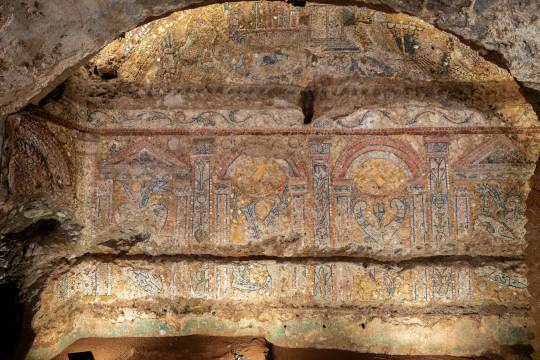
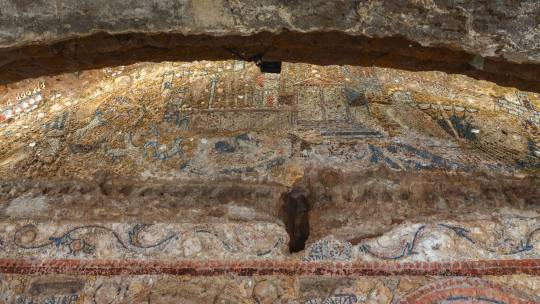
‘Incredible’ Mosaics Were Found in an Ancient Luxury Home in Rome
Italy’s Culture Minister Gennaro Sangiuliano has called the works “an authentic treasure.”
Researchers working in the Archaeological Park of the Colosseum in Rome have shared their discovery of luxurious mosaic-tiled rooms found in an ancient home on the site, which they believe may have belonged to a Roman senator. Created from shells, glass, white marble, and Egyptian blue tiles, the mosaics have been described by Italy’s Culture Minister Gennaro Sangiuliano as “an authentic treasure”.
The “rustic” mosaics, found on the grounds surrounding the Colosseum in the heart of the city, date to the late Republican Age, in the last decades of the second century B.C.E., and show a series of figurative scenes. They once decorated a townhouse, or domus, owned by an upper class citizen. Italy’s Ministry of Culture have said that “due to the complexity of the scenes depicted” and their age, the mosaics are “without comparison.”

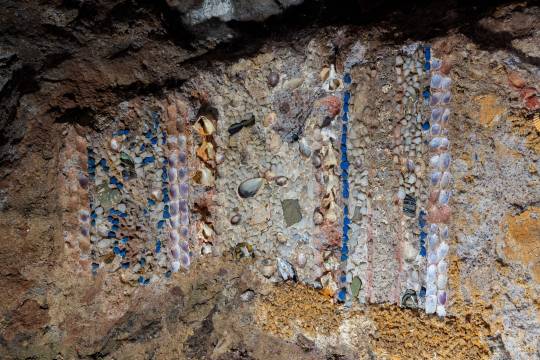

One mosaic depicts a coastal city with towers and porticos, with three large ships floating by on the ocean waves. The culture ministry believes this could be a reference to naval victories achieved by the owner of the home, which is believed to have been a Roman senator. This is supported by historical sources describing the area as having been occupied by such high-ranking members of society.
The decorated walls were likely located in the home’s dining rooms, where luxurious banquets would be hosted, and guests at these events were likely wowed with “spectacular water games,” according to the culture ministry, based on the presence of lead pipes set into the walls.
In the reception room, an extremely well preserved decorated stucco featuring landscapes and figures was also discovered. Other designs include vines and lotus leaves flowing from vases, musical instruments, and tridents.

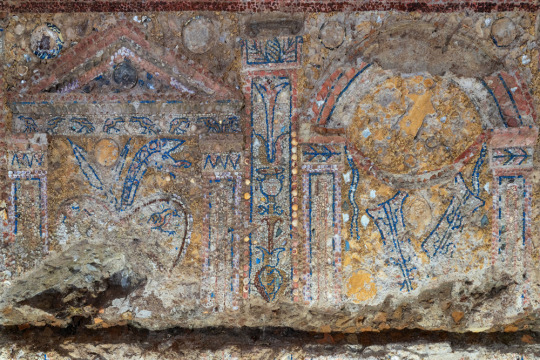

The mosaic walls were first discovered near the Colosseum in 2018, but excavation at the site will continue into 2024, and more rooms could be discovered. Alfonsina Russo, the Director of the Archaeological Park of the Colosseum, has said that once the domus is full uncovered, “we will work intensely to make this place, among the most evocative of ancient Rome, accessible to the public as soon as possible.”
By Verity Babbs.
#‘Incredible’ Mosaics Were Found in an Ancient Luxury Home in Rome#Archaeological Park of the Colosseum#Late Republican Age#second century B.C.E.#mosaic#roman mosaic#ancient artifacts#archeology#archeolgst#history#history news#ancient history#ancient culture#ancient civilizations#ancient rome#roman history#roman empire#roman art
1K notes
·
View notes
Text
2023 so far:
11th January: Florence. Tourists tie their luggage to the Baptistery.
11th January: Santa Teresa di Riva. German tourist steals sand from Italian beaches to sell it to collectors abroad.
15th January: Venice. Northern African tourist jumps into the Gran Canal.
26th January: Florence. American tourist drives his car onto the Ponte Vecchio.
12th February: Porto Torres. French tourist tries to steal fossils.
13th February: Florence. Spanish tourist writes onto the parapet of the Ponte Vecchio.
10th March. Sestriere. American tourist causes an avalanche.
12th March: Rome. British tourist jumps into the Trevi Fountain to steal coins.
20th March: Florence. American tourist parks his car in the Piazza della Signoria.
21st March: Florence. Tourist writes her name onto the parapet of the Ponte Vecchio.
24th March: Venice. British tourist climbs on top of a building and jumps into the Gran Canal.
24th March: Venice. Spanish tourist jumps into the Gran Canal.
11th April: Lenzari. German tourist steals water from the locals in the midst of severe drought to fill his pool.
13th April: Rome. British tourist bathes in the Trevi Fountain.
14th April: Herculaneum. Canadian tourist tries stealing ancient ruins.
18th April: Venice. Tourist undresses in public.
26th April: Rome. Tourist climbs the Trevi Fountain to take a selfie.
30th April: San Prisco. French tourist found with 5 kg of hashish.
2nd May: Florence. Albanian tourist writes his girlfriend’s name onto the parapet of the Ponte Vecchio.
5th May: Riomaggiore. Armed French tourist refuses to pay hotel bill and shoplifts souvenirs.
5th May: Ancona. Drunk British tourist rings multiple doorbells in the middle of the night.
6th May: Agrigento. American tourist drives his car onto ancient stairs.
13th May: Milan. American tourist tries to rape a woman.
24th May: Rome. British tourist flies a drone over the Colosseum.
29th May: Ravello. Tourist drives his scooter inside the historic centre.
30th May: Fiumicino. Tourist jumps into a fountain to take a shower.
2nd June: Naples. Tourists eat lunch using the Fontana del Carciofo as table.
4th June: Rome. Tourist bathes in the Trevi Fountain.
17th June: Cecina. British tourists jump into a fountain.
19th June: Furore. Tourist climbs the parapet to jump into the water and falls.
19th June: Rome. Tourist bathes naked into an ancient fountain.
21st June: Rome. Tourist swims into the Trevi Fountain.
23rd June: Capri. Iraqi tourist steals a bag.
26th June: Rome. Bulgarian-British tourist engraves his and his girlfriend’s names onto the Colosseum.
27th June: Olbia. Hungarian tourist steals 1 kg of sand from the beaches of Olbia and Castelsardo.
30th June: Sorrento. Tourist jumps into a fountain.
30th June: Berbenno di Valtellina. German tourist commits multiple traffic violations.
3rd July: Capri. Argentinian tourists steal from several shops.
5th July: Cala Sant’Andrea. French tourist trespasses a protected area with his catamaran.
6th July: Santo Stefano di Cadore. German tourist kills child, father, grandmother and wounds child, mother and grandfather.
8th July: Trento. Tourists bathe in the Fontana del Nettuno.
9th July: Padua. German tourists have a picnic in the middle of the Piazza dei Signori.
10th July: Atrani. Tourist undresses in the historic centre.
11th July: Venice. Tourist jumps into the canal.
11th July: Florence. Northern European tourist writes her name onto the parapet of the Ponte Vecchio.
11th July: Maiori. Tourist hits Italian woman with his scooter.
14th July: Rome. Swiss tourist engraves her name onto the Colosseum.
14th July: Rome. American tourists bathe in the Fontana dell’Acqua Paola.
14th July: Muravera. Hungarian tourist parks his car on the beach.
15th July: Anzio. Tourists severely litter the archaeological area inside the beach.
15th July: Gallipoli. Tourists beat up an Italian teenager.
15th July: Cala Lunga di Porto Massimo. French tourists violate maritime law and hit Italian woman who called them out.
16th July: Rome. German tourist defaces the Colosseum.
16th July: Rome. Tourist jumps into the Trevi Fountain.
17th July: Porlezza. Dutch tourist on a boat hurtles among swimmers in the Lake of Como.
19th July: Rimini. French tourist abandons her children in a hotel to go binge-drinking and drives while drunk.
20th July: Salerno. Police reveal that over 600 foreign tourists have been fined since January.
21st July: Rome. Tourist bathes naked in a fountain.
21st July: Portoferraio. Tourists drive their car on historical staircase.
22nd July. Polignano a Mare. Ukrainian tourist trespasses, climbs a house and jumps into the sea.
22nd July. Vicenza. American soldiers vandalise the Basilica Palladiana.
26th July. Cala Coticcio. Rich tourists set up a gazebo on the beach.
27th July. Gelso. Tourists cause a fire which destroys hectares of vegetation.
28th July. Rome. Tourist climbs and jumps into the Trevi Fountain.
29th July. Verona. Tourist sets up a hammock in the Piazza Indipendenza.
30th July. Castelfranco Veneto. Drunk Swiss tourists jump into the castle ditch.
31st July: Elba. Hungarian tourist films naked children on the beach.
2nd August: Rome. Tourist climbs the Trevi Fountain to refill her bottle.
2nd August: Viggiù. German tourists destroy a valuable statue (worth €200,000).
3rd August: Duino. Armed German tourist illegally fishes in the port.
5th August: Rimini. Drunk German tourist robs a supermarket.
7th August: Pisa. French tourist engraves her name onto the Leaning Tower.
7th August: Brunate. French tourist assaults an Italian woman.
7th August: Selargius. English tourist drives a car into a park.
11th August. Milan. French tourists climb the main spire of the Duomo to take a selfie.
11th August. Rimini. German tourists create disorder and clash with the police.
12th August. Rome. French tourist jumps into a fountain.
16th August. Cattolica. French tourists plunder a warehouse.
17th August. Venice. Tourists nap on ancient graves.
18th August. Is Arutas. German tourist steals sand from the beach and tries to sell it on eBay.
20th August. Florence. American tourist drives a car onto the Ponte Vecchio.
23rd August. Alghero. Spanish tourist tries to steal rocks from the beach.
23rd August. Caorle. Czech tourist drive while drunk.
23rd August. Florence. German tourists vandalise the Corridoio Vasariano.
24th August. San Miniato. Tourist writes his name onto the walls of the Rocca.
24th August. Rome. Tourist jumps into the Fontana del Tritone.
24th August. Rome. Tourists break into the Colosseum at night.
26th August. Valdidentro. French tourists light a fire inside a Medieval church and deface ancient frescoes.
26th August. Venice. French tourists abandon their dogs inside a car parked under the sun.
26th August. Venice. French tourist jumps into the Gran Canal.
26th August. Rome. Tourist climbs trespasses the Imperial Fora at night and climbs an ancient column.
29th August. Porto Torres. French tourist tries stealing 41 kilogrammes of rocks.
30th August. Stintino. Tourist tries stealing sand from the beach.
31st August. Porto Torres. Tourist tries stealing 7,5 kilogrammes of seashells, rocks and sand.
31st August. Milan. Drunk Australian tourist climbs BnB’s roof and throws tiles in the street.
1st September: Stintino. Tourists attempt stealing stones from the beach.
4th September: Florence. German tourist climbs and damages Neptune’s Fountain to take a picture.
4th September: Rome. Australian tourist flies drone over the Colosseum.
7th September: Venice. Polish tourist skates through the streets and jumps into the Gran Canal.
8th September: Pontassieve. Ukrainian tourist stabs BnB’s owner.
9th September: Taranto. American tourist refuses to pay for gas and threatens gas station employees.
10th September: Rome. Tourists swim in the Trevi Fountain.
10th September. Venice. Brazilian tourist jumps into the Gran Canal.
10th September. Rome. Australian tourist jumps into the Trevi Fountain.
11th September. Padenghe. Drunk German tourist attempts breaking into a house.
11th September. Rome. Tourists jump into the Trevi Fountain.
13th September. Venice. Czech tourist jumps naked into the Gran Canal.
17th September. Pisa. Drunk English tourist crashes a shop’s window.
19th September: Rome. Ghanian tourist bathes into the Barcaccia Fountain.
22nd September. Positano. Drunk American tourists insult and fight locals.
23rd September. Civitanova. Belgian tourists leave café without paying the €80 bill.
25th September. Venice. Polish tourists drive their bicycles into the Piazza San Marco.
26th September. Venice. Tourists attack the waiters.
29th September. Milan. Tourists jump off the Darsena Bridge.
30th September. Rome. Tourists bathe into the Trevi Fountain.
1st October: Asinara. French tourists access a protected area with their boat.
1st October: Rome. Tourist bathes into one of the fountains in the Piazza Navona.
3rd October: Venice. Slovenian tourists climb monument.
3rd October: Venice. Tourist swims in the San Marco basin.
5th October: San Quirico d’Orcia. Tourists set up a tent in the 16th-century gardens.
#I’m surprised there’s so few?? Cause last year there were dozens of cases so I think I’m probably missing a lot#Ah me misera!
25 notes
·
View notes
Text
Blog 6: A Journey Through History

As I wandered through the ancient streets of Rome, Italy, I was struck by the palpable sense of history that enveloped me. Each cobblestone pathway seemed to whisper tales of past eras, inviting me to delve deeper into the rich tapestry of human experience. In Edward Hyams' profound reflection, "There is no peculiar merit in ancient things," he prompts us to reconsider the value we attribute to the relics of the past (Hyams). Drawing from my immersive experience in Rome and insights from scholarly sources, this blog post seeks to unpack Hyams' quote and explore the enduring significance of history, using my journey through Rome as a lens.
Hyams contends that integrity, not age, is what truly matters, challenging the idea that merit can only be attained by antiquity. This struck a deep chord with my memories of my time spent in Rome, where the enduring buildings and relics served as witnesses to centuries of human history. A framework for comprehending the interdependence of the past and present was offered by Beck, Cable, and Knudson's debate on the function of interpretation in fostering personal identities through historical narratives (Beck, Cable, & Knudson, 2018). As I marvelled at the Colosseum's magnificence, I understood that its significance came from the stories it told and the cultural identity it represented, not only from its antiquity.
Coherence and unity in historical interpretation are crucial, as Hyams emphasizes honesty as the foundation of merit. This idea is supported by Fleischner's definition of natural history, which emphasizes the importance of maintaining the integrity of environmental narratives by deliberate attention to the world outside humans (Beck, Cable, & Knudson, 2018; Fleischner, 2002). As I thought back on my interactions with local naturalists and citizen scientists in Rome's parks, I realized how important their work is in preserving the integrity of natural ecosystems and encouraging a closer relationship with the natural world.
Hyams emphasizes the need to comprehend and conserve historical narratives when he states that integrity requires knowledge of and remembrance of the past. Upon visiting Rome's museums and archaeological sites, I was astounded by the care with which ancient items and the stories they told had been preserved. This concept was echoed by Miller-Rushing et al.'s consideration of citizen scientists' contributions to natural history documentation, emphasizing the value of collective memory in historical interpretation (Beck, Cable, & Knudson, 2018; Miller-Rushing et al., 2012).
Hyams's moving illustration of a train station serves as a timely reminder of the mistake of ignoring the past. History transcends time to influence our present and future, just like a train station survives after it passes by. This comparison struck a chord with my travels to Rome, where the streets were alive with the echoes of long-gone civilizations, serving as a constant reminder of the influence of the past on modern culture.
Edward Hyams' quote challenges us to reevaluate our perception of history and its significance. Through my journey in Rome and insights from scholarly sources, I have come to appreciate the timeless wisdom embedded in historical narratives. True merit lies not in antiquity alone but in the integrity, coherence, and enduring impact of historical interpretation. As interpreters of history and environmental narratives, we bear the responsibility of preserving and sharing these stories, ensuring that the lessons of the past continue to resonate with future generations.


References:
Beck, L., Cable, T. T., & Knudson, D. M. (2018). Interpreting Cultural and Natural Heritage for a Better World (1st ed.). Sagamore Publishing.
Fleischner, T. L. (2002). Quoted in Interpreting Cultural and Natural Heritage for a Better World (1st ed.). Sagamore Publishing.
Hyams, E. (n.d.). "The Gifts of Interpretation." Retrieved from [insert link here].
Miller-Rushing, A. J., Primack, R., & Bonney, R. (2012). Quoted in Interpreting Cultural and Natural Heritage for a Better World (1st ed.). Sagamore Publishing.
6 notes
·
View notes
Text
tourist visiting places
Here's a list of some popular tourist visiting places around the world:
Paris, France: Known as the City of Light, Paris offers iconic landmarks such as the Eiffel Tower, Notre-Dame Cathedral, Louvre Museum, and charming neighborhoods like Montmartre and Le Marais.
Rome, Italy: Explore ancient history in Rome with attractions like the Colosseum, Roman Forum, Pantheon, and Vatican City, home to St. Peter's Basilica and the Sistine Chapel.
Kyoto, Japan: Experience traditional Japanese culture in Kyoto with its historic temples, shrines, and gardens, including Kinkaku-ji (Golden Pavilion), Fushimi Inari Shrine, and Arashiyama Bamboo Grove.
New York City, USA: Discover the vibrant energy of New York City with iconic sights such as Times Square, Statue of Liberty, Central Park, Empire State Building, and Broadway theaters.
Machu Picchu, Peru: Journey to the ancient Incan citadel of Machu Picchu, nestled in the Andes Mountains, and marvel at its breathtaking panoramic views and archaeological wonders.
Santorini, Greece: Experience the beauty of the Greek islands in Santorini with its whitewashed buildings, stunning sunsets, volcanic beaches, and picturesque villages like Oia and Fira.
Dubai, United Arab Emirates: Explore the modern and luxurious city of Dubai with its skyscrapers, shopping malls, desert safaris, Burj Khalifa, Palm Jumeirah, and vibrant nightlife.
Cape Town, South Africa: Discover the natural beauty of Cape Town with attractions like Table Mountain, Cape Point, Robben Island, Kirstenbosch Botanical Gardens, and scenic coastal drives.
Rio de Janeiro, Brazil: Experience the vibrant culture of Rio de Janeiro with its famous beaches like Copacabana and Ipanema, Christ the Redeemer statue, Sugarloaf Mountain, and samba music and dance.
Sydney, Australia: Enjoy the laid-back lifestyle of Sydney with landmarks such as the Sydney Opera House, Sydney Harbour Bridge, Bondi Beach, Royal Botanic Garden, and Darling Harbour.
These are just a few examples of the countless amazing destinations around the world waiting to be explored. Whether you're interested in history, culture, nature, or adventure, there's something for every type of traveler to discover and enjoy.
0 notes
Link
0 notes
Text
Constantly searching for views that take my breath away.
Travel in South India:
Traveling in South India offers a diverse and enriching experience, with its rich cultural heritage, historical landmarks, vibrant festivals, and diverse landscapes. Here's a brief guide to help you plan your trip to South India:
Destinations:
1.Chennai, Tamil Nadu:
Explore the Marina Beach, one of the longest urban beaches in the world.
Visit the Kapaleeshwarar Temple and San Thome Basilica.
Experience the vibrant arts scene at Kalakshetra.
2.Pondicherry:
Enjoy the French colonial architecture in the White Town.
Relax at the Promenade Beach and Auroville.
Explore Aurobindo Ashram for spiritual insights.
3.Mahabalipuram, Tamil Nadu:
Discover UNESCO World Heritage Sites like the Shore Temple and the Five Rathas.
Witness exquisite stone carvings and sculptures.
4.Bangalore, Karnataka:
Visit Lalbagh Botanical Garden and Cubbon Park.
Explore the Bangalore Palace and Tipu Sultan's Summer Palace.
5.Mysuru, Karnataka:
Experience the grandeur of Mysuru Palace.
Visit the Chamundi Hills and the vibrant Devaraja Market.
Travel in North India..
Traveling in North India offers a diverse and fascinating journey through historical cities, architectural wonders, and breathtaking landscapes. Here are some key destinations to consider:
1.Delhi:
Explore historical sites like the Red Fort, Qutub Minar, and Humayun's Tomb.
Visit India Gate and the Lotus Temple.
Experience the vibrant street markets of Chandni Chowk.
2.Agra, Uttar Pradesh:
Marvel at the iconic Taj Mahal, a UNESCO World Heritage Site.
Explore the Agra Fort and Fatehpur Sikri
3.Jaipur, Rajasthan:
Discover the Pink City with its palaces, including Hawa Mahal and City Palace.
Visit the Amber Fort and the Jantar Mantar observatory.
Shop for traditional Rajasthani crafts in the local markets.
4.Varanasi, Uttar Pradesh:
Experience the spiritual and cultural richness along the ghats of the Ganges River.
Visit the Kashi Vishwanath Temple and the Sarnath archaeological site.
5.Rishikesh and Haridwar, Uttarakhand:
Explore the spiritual centers on the banks of the Ganges.
Engage in yoga and adventure activities in Rishikesh.
Hill Station..
Hill stations in India are popular destinations, especially during the summer months, offering a cool and refreshing escape from the heat. Here are some notable hill stations in both North and South India:
1.Shimla, Himachal Pradesh:
Known for its colonial architecture, Mall Road, and the Ridge.
Take a ride on the Kalka-Shimla Toy Train.
Enjoy panoramic views from Jakhoo Hill.
2.Manali, Himachal Pradesh:
Surrounded by snow-capped mountains and lush greenery.
Adventure activities like paragliding and skiing.
Visit the Hadimba Devi Temple and Solang Valley.
3.Nainital, Uttarakhand:
Nestled around the Naini Lake.
Boat rides on the lake and a visit to Naina Devi Temple.
Enjoy the views from Snow View Point.
4.Mussoorie, Uttarakhand:
Known as the "Queen of Hills."
Explore Camel's Back Road and Mall Road.
Visit Kempty Falls and Gun Hill..
Popular World Destinations..
There are countless popular destinations around the world, each offering unique experiences, cultural richness, and natural beauty. Here's a list of some widely celebrated destinations:
1.Paris, France:
Iconic landmarks like the Eiffel Tower and Louvre Museum.
Charming neighborhoods and world-class cuisine.
2.Rome, Italy:
Ancient ruins such as the Colosseum and Roman Forum.
Vatican City with St. Peter's Basilica and the Sistine Chapel.
3.Barcelona, Spain:
Unique architecture by Antoni Gaudí, including Sagrada Familia.
Vibrant street life and Mediterranean beaches.
4.Santorini, Greece:
Stunning white-washed buildings against the backdrop of the Aegean Sea.
Beautiful sunsets and unique volcanic landscapes.
Popular destination in Asia..
Asia is a vast and diverse continent with a plethora of popular destinations. Here are some well-known and highly visited places in Asia:
1.Tokyo, Japan:
High-tech city life alongside traditional temples and gardens.
Unique districts like Shibuya and Akihabara.
2.Kyoto, Japan:
Historic tHigh-tech city life alongside traditional temples and gardens.
Unique districts like Shibuya and Akihabara.
3.Beijing, China:
The Great Wall of China and the Forbidden City.
Modern architecture and vibrant street markets.
4.Bali, Indonesia:
Beautiful beaches, lush rice terraces, and vibrant cultural scene.
Hindu temples like Uluwatu and Tanah Lot.emples, traditional tea houses, and beautiful gardens.
Geisha culture and the Fushimi Inari Shrine.
3.Beijing, China:
The Great Wall of China and the Forbidden City.
Modern architecture and vibrant street markets.
4.Bali, Indonesia:
Beautiful beaches, lush rice terraces, and vibrant cultural scene.
Hindu temples like Uluwatu and Tanah Lot.
0 notes
Text
A Chrome Spectacle: Wildlife Encounters in Kruger National Park
The entire world is really a value trove of captivating places, each supplying a unique mixture of tradition, history, and normal beauty. From old wonders to modern marvels, these tourist attractions beckon tourists with promises of memorable experiences. In this short article, we will set about a virtual trip to discover several distinguished tourist locations, each adding its distinct elegance to the tapestry of global travel.
The Pyramids of Giza:
Our first end is in the center of Egypt, where the Pyramids of Giza stay tall as an enduring testament to individual ingenuity. These old miracles have fascinated explorers and historians for generations, with the Good Pyramid helping as a symbol of architectural prowess and the mysteries of old civilizations.
Banff National Park:
Going to the Canadian Rockies, Banff National Park unfolds as a majestic landscape of perfect seas, magnificent hills, and abundant wildlife. From the renowned Lake Louise to the picturesque Icefields Parkway, Banff offers a haven for outside lovers seeking adventure amidst wonderful normal surroundings.
Paris, France:
Called the "Town of Lights," Paris reflects the minds of thousands having its passionate environment, well-known landmarks, and world-renowned art and cuisine. From the Eiffel System to the Louvre Memorial, every corner of Paris is steeped ever and culture, making it a perennial favorite among travelers.
Machu Picchu:
Perched saturated in the Andes Hills, Machu Picchu beckons adventurers having its ancient Incan ruins and breathtaking views. This archaeological wonder, shrouded in water and puzzle, provides a view to the rich social heritage of Peru and the design marvels of the Inca civilization. 86asik
Bali's Shores:
For those seeking sun-soaked serenity, the Indonesian area of Bali supplies a paradise of excellent beaches, vibrant coral reefs, and rich landscapes. From the holy temples to the lively markets, Bali's distinctive mixture of spirituality and natural beauty creates a charming escape.
Kruger National Park:
South Africa's Kruger National Park encourages wildlife lovers on a opera spectacle. House to the "Large Five" and a diverse array of flora and fauna, the park has an immersive experience in the center of the African-american wilderness.
Rome's Colosseum and Forum:
In the endless town of Rome, the Colosseum and Forum stand as enduring icons of historical Roman civilization. Discovering these architectural marvels transports readers back in time, allowing them to envision the grandeur of gladiator contests and the political living of the Roman Republic.
Kyoto's Temples and Gardens:
Japan's social gem, Kyoto, captivates using its serene temples, old-fashioned tea properties, and meticulously manicured gardens. A social odyssey awaits people who walk through the ancient districts and knowledge the wonder of Kyoto's spiritual heritage.
Niagara Falls:
In the borderlands of the United States and Canada, Niagara Falls roars alive, offering an all-natural wonder that leaves spectators in awe. The utter power and beauty of the falls, combined with bordering areas and attractions, create an immersive experience for readers of ages.
Realization:
From the old wonders of Egypt to the organic beauty of Banff, the global adventure through these tourist attractions reveals the varied and fascinating nature of our world. Whether seeking ethnic enrichment, outdoor experience, or simply just the beauty of nature, these destinations stand as testament to the richness and selection of our planet's offerings. As we examine these famous web sites, we get a greater appreciation for the tapestry of countries, backgrounds, and areas which make travel a really loving endeavor.
0 notes
Text
Discover the Wonders of the World: Unveiling the Most Popular Destinations on the Globe.
In a world brimming with diverse landscapes, cultures, and histories, certain destinations emerge as timeless favorites, drawing travelers from every corner of the globe. From the romantic streets of Paris to the ancient wonders of Machu Picchu, let's embark on a virtual journey to explore the most popular and enchanting destinations that capture the imagination of wanderers worldwide.
1. Paris, France: The City of Love and Lights
Paris, often referred to as the "City of Love," needs no introduction. Nestled along the banks of the Seine River, the French capital exudes an unparalleled charm that has captivated poets, artists, and lovers for centuries. The iconic Eiffel Tower stands tall, a symbol of romance and architectural splendor. Stroll along the Champs-Élysées, explore the Louvre Museum's artistic treasures, and savor a croissant in a quaint Montmartre café. Paris is not just a destination; it's an immersive experience that indulges the senses and leaves an indelible mark on the hearts of all who visit.
2. Rome, Italy: The Eternal City of History and Grandeur
Step into the heart of Italy, where the Eternal City, Rome, beckons with a tapestry of history, art, and grandeur. The Colosseum, a colossal amphitheater, echoes the roars of ancient gladiators, while the Roman Forum reveals the remnants of a once-mighty empire. Vatican City, an independent city-state within Rome, houses the awe-inspiring St. Peter's Basilica and the Sistine Chapel, adorned with Michelangelo's masterpieces. As you wander through cobblestone streets, indulging in authentic pasta and gelato, Rome offers a timeless journey through the ages.
3. Kyoto, Japan: Serenity Amidst Tradition
In the heart of Japan, Kyoto stands as a serene testament to the country's rich cultural heritage. Known for its well-preserved temples, traditional tea houses, and vibrant cherry blossoms, Kyoto offers a glimpse into Japan's soul. The historic Gion district, with its wooden machiya houses and cobbled streets, transports visitors to a bygone era. Participate in a traditional tea ceremony, witness the mesmerizing geishas, and find tranquility in moss-covered Zen gardens. Kyoto is a city that seamlessly blends tradition with modernity, creating a harmonious and unforgettable experience.
4. New York City, USA: The Concrete Jungle That Never Sleeps
On the other side of the spectrum, the vibrant and diverse metropolis of New York City welcomes travelers with open arms. The iconic skyline, dominated by skyscrapers like the Empire State Building and One World Trade Center, sets the stage for an exhilarating urban adventure. Times Square pulsates with energy, Central Park offers a green oasis in the midst of the concrete jungle, and the Statue of Liberty stands as a symbol of freedom and opportunity. From the trendy neighborhoods of Brooklyn to the cultural melting pot of Queens, New York City is a dynamic mosaic that never fails to leave an impression.
5. Machu Picchu, Peru: Ancient Marvel in the Andean Heights
High in the Andes, the ancient Inca citadel of Machu Picchu unveils itself like a hidden gem. This archaeological wonder, perched on a mountain ridge, showcases the engineering brilliance of the Inca civilization. The Inca Trail, a trek through breathtaking landscapes, leads adventurers to this UNESCO World Heritage site. As the mist clears, revealing the terraced fields and stone structures, the profound beauty of Machu Picchu leaves visitors in awe of its historical and natural magnificence.
6. Santorini, Greece: Aegean Paradise
In the sun-drenched embrace of the Aegean Sea, the Greek island of Santorini emerges as a postcard-perfect paradise. Whitewashed buildings with blue-domed roofs cling to the cliffs, creating a mesmerizing contrast against the azure waters below. The sunset in Oia is legendary, casting a warm glow over the romantic island. Explore charming villages, indulge in delectable Mediterranean cuisine, and relax on sun-kissed beaches. Santorini is not just a destination; it's a visual symphony that captures the essence of Greek beauty and hospitality.
These destinations represent just a glimpse of the world's wonders, each offering a unique and unforgettable experience. Whether you're drawn to the romantic allure of European cities, the tranquility of Asian landscapes, or the vibrant energy of urban hubs, the global tapestry of destinations awaits your exploration. As you plan your next adventure, consider these popular destinations, where the beauty of the world unfolds in myriad ways, inviting you to be a part of its story. So, pack your bags, embrace the unknown, and let the journey of a lifetime begin.
1 note
·
View note
Text
Rome’s Top Monuments And Attractions In 2023
As of my last knowledge update in September 2021, I can provide you with a list of some of Rome's top monuments and attractions. Please note that the popularity of can change over time, and new ones may have emerged since then. I recommend checking the most recent information and reviews when planning your visit to Rome in 2023. Here are some iconic attractions that were popular in 2021:
Colosseum tour: This ancient Roman amphitheater is a symbol of Rome and a must-visit historical site. It's best to book tickets in advance to skip the long lines.
Roman Forum: Adjacent to the Colosseum, the Roman Forum is a fascinating archaeological site showcasing the heart of ancient Rome's political and social life.
Pantheon: A remarkable temple-turned-church with a stunning dome and a well-preserved interior. It's a marvel of ancient engineering.
Vatican City: Home to St. Peter's Basilica, the Vatican Museums, and the Sistine Chapel, Vatican City is a must-visit for art, history, and religious enthusiasts.
Trevi Fountain: One of the most famous fountains in the world, the Trevi Fountain is known for its intricate design and the tradition of tossing a coin over your shoulder to ensure your return to Rome.
Spanish Steps: A grand staircase leading to the Trinità dei Monti church, it's a popular spot for people-watching and taking in the city views.
Piazza Navona: A lively square with beautiful Baroque architecture, it's a great place to enjoy street performances and dine at outdoor cafes.
Villa Borghese: A large park offering a peaceful escape from the city, with beautiful gardens, museums, and a lake where you can rent rowboats.
Castel Sant'Angelo: Originally built as a mausoleum for Emperor Hadrian, this castle has served various purposes over the centuries and offers great views of the city.
Capitoline Hill and Museums: One of Rome's seven hills, it houses a collection of art and archaeological museums, as well as the stunning Piazza del Campidoglio.
Piazza Venezia: Dominated by the massive Monument to Vittorio Emanuele II, this central square is a hub of traffic and history.
Basilica of San Clemente: This unique church has multiple layers of history, with a medieval basilica built on top of an earlier Christian church, which is in turn built over a Roman house.
Remember that Rome is a city rich in history and culture, and there are countless more attractions, museums, churches, and hidden gems to discover. Depending on your interests, you may want to explore different neighborhoods, art galleries, and local markets to get a deeper sense of the city's character. Be sure to check for any updates, ticket information, and visitor guidelines before your trip in 2023.
0 notes
Text

Rome’s 'Lost' Imperial Palace 'Domus Tiberiana' Reopens
Until recently a crumbling and off-limits ruin near the famous Colosseum, the Domus Tiberiana palace — built in the first century AD and beloved by Nero — hopes to once again take its place as one of the city’s top tourist attractions.
The ancient palace sits on Palatine Hill — the city’s oldest hill, overhanging Rome —from where imperial dynasties ruled for centuries. But over the years, the site fell into disrepair and in the 1970s, the Domus Tiberiana site was shut due to the structural instability of some of the ruins. The closure left behind what many Romans described as a “black hole” in the capital’s archaeological heart.
Now, after a six-year makeover, the palace has reopened its doors as a “diffuse museum,” with findings and frescoes scattered across the site to provide visitors with an insight into the palace’s ancient grandeur.
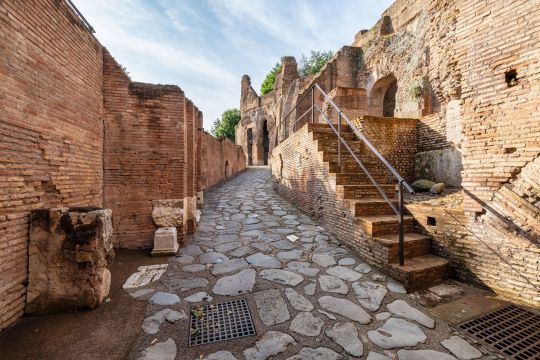
And it was grand. The Domus Tiberiana was Rome’s first imperial palace, built by the emperor Tiberius who combined and incorporated the pre-existing noble mansions built on the hill. Occupying over four hectares, the palace featured residences alongside large gardens, places of worship and rooms for the emperor’s Praetorian guard.
As the seat of Rome’s power and politics, Domus Tiberiana held a prime location, high above the Palatine and Roman Forums, offering its occupants a “balcony view of the city.” Over time, the Domus was embellished and enlarged by other emperors including Nero, who was crowned on its steps aged just 16, in 54 AD.
Alfonsina Russo, director of the Colosseum’s archaeological park (in which Domus Tiberiana falls) and lead archaeologist on the renovation, said that ancient antiquities, many exceptionally well-preserved, were unearthed during the project.
The artifacts — bright stuccos, frescoes, amphorae, potteries, looms, terracotta, and divinity statues related to the cults of Isis, Dionysius and Mithras — offer visitors a trip through time, said Russo.

“They make this place — formerly (inhabited) by aristocratic families, then Roman emperors — feel alive again,” she said. “There are seven exhibition rooms full of extraordinary finds, starting with those preceding the original construction of the palace when aristocrats lived in mansions before Tiberius subsumed them into the Domus.”
Among the newly-exposed and frescoes are some of the earliest paintings of lemons (considered an exotic fruit in Ancient Rome, as they hailed from the Far East) and a depiction of a gladiator, proving that the era’s gladiatoral games were appreciated by rich families, explained Russo.
The imperial palace remained in use until the 7th century, when it became the papal residence of John VII. In the mid-16th century, the aristocratic Farnese family — who were powerful local landowners — built the lavish Orti Farnesiani gardens on the site, adorning it with ornaments and sculptures of nymphs, satyrs and fauns.
“This monument speaks of history,” Russo added. “We have restored (Domus Tiberiana) to its past splendor, but more work lies ahead.”
Indeed, painstaking efforts have been made to blend old and new. A series of majestic, reddish-brown vaulted arches that greet visitors having been carefully reconstructed with the same materials as ancient Romans used in the past.
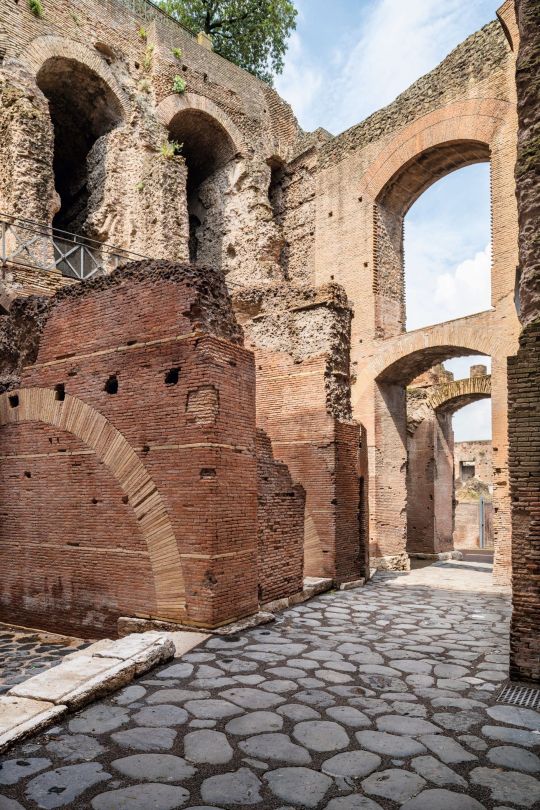
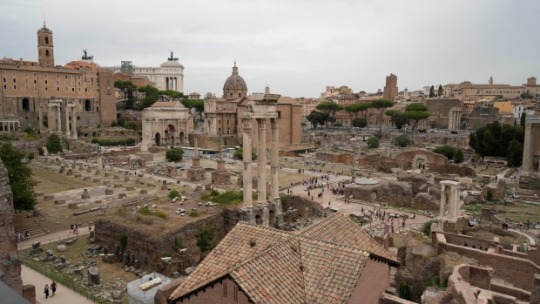
“What makes this revamped Domus unique is the architectural style,” said Russo. “We managed to use original materials to reinforce and strengthen the handmade 15-meter (50ft) tall front arches (which run alongside the palace’s) ancient paving.”
It has certainly caught the public’s attention. Since reopening at the end of September, Domus Tiberiana has attracted some 400,000 visitors, a “huge success,” said Russo, adding that she believes that this incarnation of the Domus Tiberiana offers visitors the most “evocative” visit in generations.

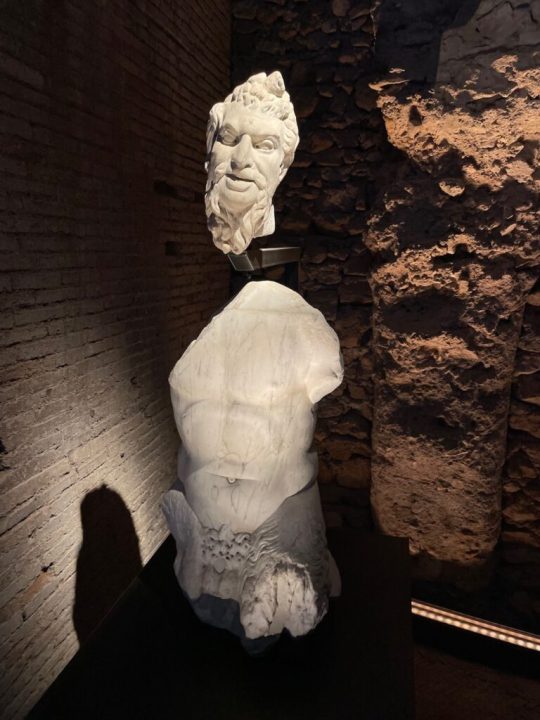
Archaeologist and scholar of ancient Rome Giorgio Franchetti saidN that, in the reopening of the Domus Tiberiana complex, Rome has “recovered a lost jewel.”
“The Palatine Hill has always been the stage of Rome’s power politics,” he said in an interview. “Tiberius likely chose this spot to build the palace as it was where his family residence stood. There aren’t many places like the Domus Tiberiana where you can really breathe the past.”
By Silvia Marchetti.
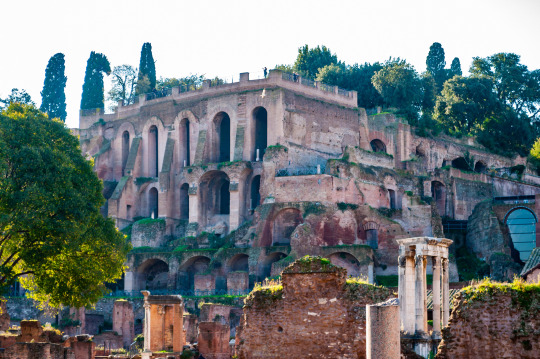
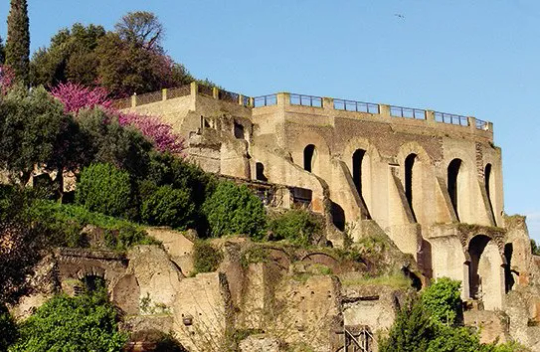
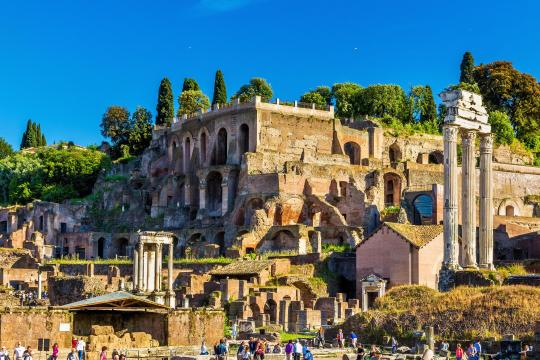
#Rome’s 'Lost' Imperial Palace 'Domus Tiberiana' Reopens#Domus Tiberiana palace#Palatine Hill#Emperor Tiberius#Emperor Nero#ancient artifacts#archeology#archeolgst#history#history news#ancient history#ancient culture#ancient civilizations#ancient rome#roman history#roman empire#roman emperor#roman art
264 notes
·
View notes
Link
0 notes
Text
Italy's Colosseum warns of jail time for tourists who deface landmark
Colosseum urges tourists to respect heritage.
The Colosseum archaeological park has published a notice on its website warning of prison sentences of up to five years and hefty fines for those who vandalize the monument.
The awareness campaign follows a spate of recent incidents in which tourists carved their names into the walls of the Colosseum, sparking widespread outrage in Italy and around…
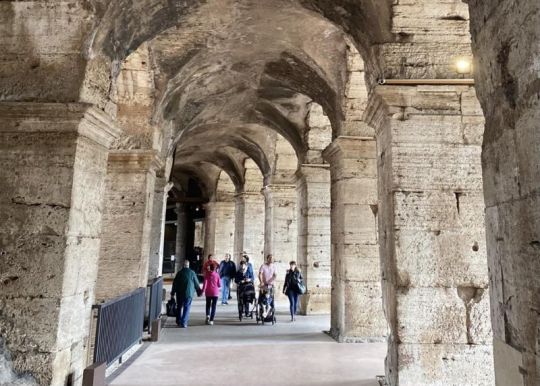
View On WordPress
0 notes
Photo










MÅNESKIN | Backstage of “Star Walks: Vent'anni at the Colosseum’s Archaeological Park.”
#maneskin#måneskin#maneskinedit#måneskinedit#italiansedit#ethan torchio#victoria de angelis#damiano david#thomas raggi#maneskinsource#dailymusicians#backstage#gifs#mine
2K notes
·
View notes
Note
I have updated my "Animorphs in Italy" AU, because I hadn't considered some logistical issues around location. It's so interesting to think how much the series would change if it was set in a rather different culture, as continental Europe.
Italy, and Europe in general, is much more densely populated than either the US, Australia or Canada. Hence, to make sure that Ax and Tobia (by the way Tobia is a very unusual name in Italy, but it really suits him!) have a hideout place, we are limited to areas reasonably close to a national park. I think Amalfi would be a great choice, because of its mild weather that resembles California's, as well as its proximity to the seaside, to a regional park and to Naples, which is a major city.
Tobia will have to get stuck as a Common Buzzard (which is native to the area, phew!) and to put up with Rachele (Rachel) being a Golden Eagle. To fly around, it might be smart to be seagulls, but they're never smart about it.
Battle morphs will definitely have to come from a zoo, because there are no big wild animals in Italy. Ax (who gets to keep his Andalites name) will definitely not be able to morph shark if his dome crashes in the Mediterranean Sea. However, if he's lucky, he'll get a dolphin. On the bright side, Animorphs won't have to endure freezing water during their sea missions.
I have also realised that skunks don't exist in Europe, hence Visser 3 won't get sprayed. :(
Giacomo (Jake) and Tommaso (Tom) would definitely be playing football (as in soccer). Tommaso used to be star of the junior division of SSC Napoli, but he obviously gave it up as a controller. Similarly, Giacomo's hero is obviously Diego Maradona (instead of Michael Jordan).
The sharing should probably be a Catholic institution. Using a Catholic Church as a shady place has already be done on Midnight Mass, so apparently it's OK.
Yeerks definitely wouldn't be able to dig an underground pool, because of too many archaeological findings, so it would have to be an actual swimming facility, (somehow) linked to the Church.
Unfortunately, Don Enrico (Hedrick Chapman) will have to be a priest, meaning that Melissa wouldn't exist :'(
The Davide (David) trilogy will be abozut preventing yeerks from infiltrating the Vatican.
There will have to be some occasions to visit Rome and Ax will be impressed by the Ancient Roman ruins, yet horrified hearing about the purpose of the Colosseum.
The Chee will definitely brag about having survived the eruption Mount Vesuvio in 79 AD. However, they'll also have to admit that they stood there while letting everyone in Pompeii and Herculaneum be killed. This non-interference policy will be a major plot line in one of the books.
Because it's the 90s, I'm afraid they're all likely to be ethnically white. However, Marco (not only does he get to keep his Italian name, but he's also one of the several Marcos in his class) will look very South Italian (olive skin, black hair and eyes), which pretty much as close as it gets to Canon.
Giacomo and Rachele can still be fair skin and blond. Not sure what to do about Camilla though (Cassie - Cassandra would be too weird).
Tobia has recently moved from his aunt's house near Venice. Because he speaks with a North-East accent, the others kids make fun of him.
Since classic anime were already an important part of pop culture in Italy, Rachele's nickname will be "Lady Oscar" (from The Rose of Versailles), instead of Xena.
Since in Italian schools students don't rotate classrooms, they're all classmates. Marco would be the one who always wants to sit in the back. However, since he's the class clown, teachers will make him sit in a first row desk.
The Animorphs will have less time for weekend battles, because they will have to go to school on Saturdays. However, they'll be more free in the afternoons . Instead of hanging out at the mall, they'll probably meet in a square in town or by the beach (in Summer). Also, they won't be eating hamburgers or food court junk food, yet they'll have street food and pizza.
Ax will have a great time in Italy because of food. He'll finally get to try pizza, pasta and gelato, which would make this AU better for him. Period. He would have difficulties eating spaghetti in a civilised manner, and will complain about forks being inefficient for the purpose. He might even dare to suggest that using a spoon makes it more convenient.
Ax would also piss off the locals by ordering cappuccino after 11am. To put a remedy on it, Giacomo will have to introduce him as his British cousin.
Ax' favourite food will be tiramisù, and he'll get salmonella at least once for buying it from cheap places.
There will be no school dances, only informal house parties. Hence, Giacomo Rachele and Camilla will likely be the only ones invited. Once they reach liceo (high school), things will change and they'll all crush the parties, as adults won't be supervising. Parties on the beach can also be featured. At that point, parties might probably involve alcohol, so we'll get to see drunk Ax (yay!). There will also be some drama about drunk Ax being unable to Demorph.
In MM3, Visser 4 will try to change the Gallic Wars by murdering Julius Caesar (as his host was obsessed with the last canto of Dante's Inferno), a battle with Garibaldi during Italian Risorgimento, and he'll go to the the University of Pisa to kill Galileo Gailiei (though another option is the Medici court to kill Leonardo Da Vinci). Instead of D day, the final battle would have to be the battle of Anzio, the town where the Allies landed in 1944. However, since the previous events were changed, Italy as a country wouldn't probably exist at all by that point.
Bless.
#animorphs#animorphs au#animorphs meta#italy#location au#place au#having never lived in italy i have nothing to add#i trust you utterly
92 notes
·
View notes
Text
Archaeologists Discovered a Hidden Chamber in Roman Emperor Nero's Underground Palace

Archaeologists have discovered a hidden vault in the ruins of Roman Emperor Nero's sprawling palace, hidden under the hills near Rome's ancient Colosseum. According to a statement (translated from Italian) from the Colosseum archaeological park, which includes the palace's ruins, the chamber has sat hidden for nearly 2,000 years, likely dating to between A.D. 65 and A.D. 68.
The chamber, nicknamed the Sphinx Room, is richly adorned with murals of real and mythical creatures including — you guessed it — a sphinx. Painted in rich red, green and yellow pigments that have survived the last two millennia incredibly well, the vaulted room is also decorated with images of a centaur, the goat-rumped god Pan, myriad plant and water ornaments, and a scene of a sword-wielding man being attacked by a panther. Read more.
529 notes
·
View notes